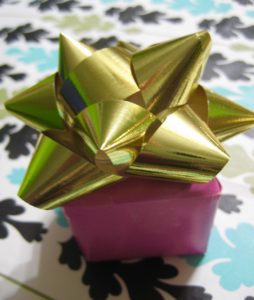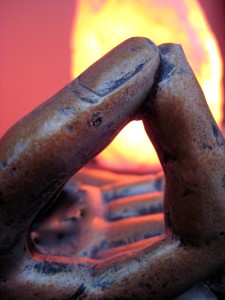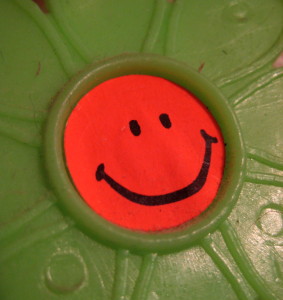“[We] are in the world to train [our]selves to be unbiased witnesses, so as to understand the mystery of ourselves and relish the exultation of finding what we really are…” – don Juan Matus*

Every year since I was very little, probably before I started school, I attended the December birthday party of a girl I knew. Our mothers were friends. She did not live in my neighborhood but she did attend the same Catholic School I did.
A lot of kids got invited, girls from school and girls from her neighborhood. The basement rec room at her house was packed with kids, parents and siblings, grandparents and anyone else who showed up. It was always a big affair. There was a table for presents, another table for birthday cake and ice cream, drinks, plates, snacks, etc., pin the tail on the donkey on the wall, a semi circle of chairs upon which all the party goers sat to play the various guessing games that we played year after year, guessing how many marbles were in a jar, how many shoelaces in another, how many chocolate kisses in another, etc. My memories of these birthday parties were that they were anxious affairs.
Why such anxiety over a birthday party? Well, each year this same scenario played out: I’d get invited. On the day of the party I would get ready. Where was the present? There wasn’t one. My mother never provided me with a gift to bring to the party. Instead I’d make a card and 2 or 3 dollar bills would go into the card.
My mother did not drive so I would need to get a ride with another friend going to the party. There was one other girl in my neighborhood who usually attended the party too. Her mother, who also had seven kids, like mine, knew how to drive and never seemed to have a problem stuffing any number of kids into her car and driving wherever needed. I usually got a lift with this mother.
One year she forgot to pick me up. I waited a long time outside in the cold, standing in my driveway wondering where she was. I waited patiently, aware that this mother often ran behind schedule. I finally went inside to find out if my mother had indeed set up a ride for me. Just then the other mother drove up, greatly apologetic. They had headed off to the party only to realize they had forgotten me and then driven all the way back to get me.
I got into the car, clutching my homemade card and feeling bad for needing the ride, only to be greeted by my friend holding in her lap a big, beautifully wrapped gift with a pretty bow on it. I was immediately embarrassed. Why couldn’t my mother do something like that? I covered my meager card with my hands, wishing I had a better, more sensitive mother. Didn’t she know you brought gifts to a party? I don’t remember ever having brought a gift.
At the party, I snuck my card onto the table laden with gifts hoping that no one would notice. When present opening began I cringed, waiting for my card to be presented to the birthday girl, usually last, sometimes not even noticed. Sometimes I’d see it lying there on the table long after the presents had been opened, unseen. When the birthday girl did finally open my card she was always thrilled, “Yay! Money!” she’d say, with such enthusiasm I had to believe she meant it.
With the party over it was time to be anxious about getting home. I’d hope that the mother from my neighborhood remembered I was riding with her. One year she left without me and the party girl’s mom had to find me another ride. Another year I had to stay on for several hours for my father to pick me up on his way home from work.
I don’t blame my mother for any of this. She didn’t drive until I was much older and so it was necessary for us to depend on the kindness of our neighbors. I have so many memories of other people driving me places, even to the hospital in emergencies. One time, when she was actually learning to drive, though I don’t think she had her license yet, my mother asked me to get into the car with her while she drove about 4 miles to the nearest little store to buy a few groceries.
She had me sit in the backseat with my littlest siblings while she bravely yet badly drove along the winding country roads to the store. She stalled the car, a stick shift, innumerable times, lurching down the road in gut-wrenching jolts, finally slamming on the brakes so hard as she arrived at the store that the car went into a long skid and we all went crashing to the floor. I remember thinking at the time—I was about 10 or 11—that when it came time for me to drive I would never drive like that!
When my mother did finally learn to drive she did so adequately enough, though she was a nervous driver and had numerous near misses. Several times while I was in the car with her she’d go off the shoulder on her side, veer over to the other lane, into oncoming traffic, and in just the last second somehow manage to swerve back into the right lane. “Well!” she’d say, and drive onward with a shake of her shoulders and a defiant aire.
One time she slammed on the brakes so hard I flew into the windshield and smashed it. I never knew why she’d done that, as we were about a quarter mile away from the car ahead of us. But this was the beginning of my ability to “see” and “know” things before they happened. I am convinced that this hard knock on the head activated my pineal gland and it has been active ever since.
As children we trust the adults in our lives to take care of us, to provide and teach us, to nurture and sustain us until we are ready to go off on our own. I vowed to myself quite often that I would do things differently from my mother, her bad driving and lack of party etiquette just two examples. But the truth was that for a long time I was depressed, felt deserted, abandoned, neglected by the mother I got, and I did blame her for a lot of things. Now I see the reality of her life, stuck in the country with a bunch of children, unable to drive and depressed, shy, and withdrawn herself. I have to admit, she did the best she could.
It wasn’t until I took responsibility for my own depression that things began to change. By taking on the challenges of my own life, I was able to release my mother from any blame and really go on to live my own life. And I discovered that: No Blame = Freedom. Freedom is truly releasing emotional attachment to what was, to what is. Freedom is pure acceptance of the truth, with judgments peeled away and lessons gained. Freedom carries no blame. Freedom is living as an “unbiased witness,” as don Juan suggests.

By the time I was in sixth grade there were no more big parties at my friend’s house. Instead there was a much smaller sleepover with just four girls that year. This was much more to my liking. The main point was to stay up all night. No problem, I couldn’t sleep anyway! Still anxious!
Oh, and at that party I brought a real gift, one I had paid for and wrapped myself, the kind of gift I knew you brought to a birthday party, tied in a big bow!
A blog by J. E. Ketchel, Author of The Recapitulation Diaries
*The Fire From Within by Carlos Castaneda, p 152



